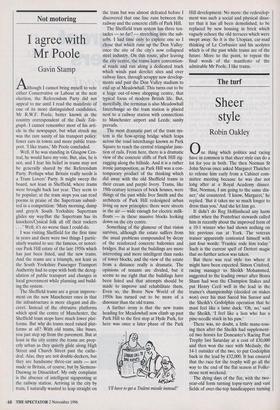Not motoring
I agree with Mr Poole
Gavin Stamp
though I cannot bring myself to vote either Conservative or Labour at the next election, the Referendum Party did not appeal to me until I read the manifesto of one of its more distinguished candidates, Mr R.W.F. Poole, better known as the country correspondent of the Daily Tele- graph. I cannot remember most of his arti- cle in the newspaper, but what struck me was the rare sanity of his transport policy: fewer cars in towns and more public trans- port. 'I like trams,' Mr Poole concluded.
Well, if he was standing in Glasgow Cen- tral, he would have my vote. But, alas, he is not, and I fear his belief in trams may not be generally shared by the Referendum Party. Perhaps what Britain really needs is a Tram Lovers' Party. It might sweep the board, not least in Sheffield, where trams were brought back last year. They seem to be popular; at the tram stops you can read poems in praise of the Supertram submit- ted in a competition: 'Misty morning, damp and grey/A South Yorkshire Supertram glides my way/But the Supertram has its knockers/Cynical folk all off their rockers ... ' Well, it's no worse than I could do.
I was visiting Sheffield for the first time in years and there were two things I partic- ularly wanted to see: the famous, or notori- ous Park Hill estate of the late 1950s which has just been listed, and the new trams. And the trams are a triumph, not least as the South Yorkshire Passenger Transport Authority had to cope with both the dereg- ulation of public transport and changes in local government while planning and build- ing the system.
The Sheffield trams are a great improve- ment on the new Manchester ones in that the infrastructure is more elegant and dis- creet. Instead of the obtrusive platforms which spoil the centre of Manchester, the Sheffield tram stops have much lower plat- forms. But why do trams need raised plat- forms at all? With old trams, like buses, you just step up from the pavement. But at least in the city centre the trams are prop- erly urban as they quietly glide along High Street and Church Street past the cathe- dral. Alas, they are not double-deckers, but they are handsome three-car units — not made in Britain, of course, but by Siemens- Duewag in Diisseldorf. My only complaint is the absence of intelligent signposting at the railway station. Arriving in the city by train, I naturally wanted to leap straight on the tram but was almost defeated before I discovered that one line runs between the railway and the concrete cliffs of Park Hill.
The Sheffield tram system has three ten- tacles — so far? — stretching into the sub- urbs. I had time only to explore one so I chose that which runs up the Don Valley: once the site of the city's now collapsed steel industry. On this route, after leaving the city centre, the trams leave convention- al roads and run along a dedicated track which winds past derelict sites and over railway lines, through scrappy new develop- ments and past the Don Valley stadium to end up at Meadowhall. This turns out to be a huge out-of-town shopping centre, that typical focus of modern British life. But, mercifully, the terminus is also Meadowhall Interchange so the tram station is placed next to a railway station with connections to Manchester airport and Leeds; sanity prevails.
The most dramatic part of the tram sys- tem is the bow-spring bridge which leaps across the road interchange known as Park Square to reach the central triangular junc- tion of rails. From here, there is a dramatic view of the concrete cliffs of Park Hill zig- zagging along the hillside. And it is a rather ironic juxtaposition, as Park Hill was a con- temporary product of the thinking which did away with the old Sheffield trams in their cream and purple livery. Trams, like 19th-century terraces of brick houses, were things of the past while Ivor Smith and the architects of Park Hill redesigned urban living on new principles: there were streets in the air — wide enough for electric milk- floats — in these massive blocks looking down on the city centre.
Something of the glamour of that vision survives, although the estate suffers from the usual problems compounded by decay of the reinforced concrete balconies and bridges. But at least the buildings are more interesting and more intelligent than ranks of tower blocks, and the view of the estate from a distance really is dramatic. The opinions of tenants are divided, but it seems to me right that the buildings have been listed and that attempts should be made to improve and rehabilitate them. Even so, the Brave New World of the 1950s has turned out to be more of a dinosaur than the old trams.
A further irony is that the new trams heading for Meadowhall now climb up past Park Hill to the first stop at Hyde Park, for here was once a later phase of the Park 7'11 have to get a Trident missile instead!' Hill development. No more: the redevelop- ment was such a social and physical disas- ter that it has all been demolished, to be replaced by new housing in brick which vaguely echoes the old terraces which were swept away. So it is the Utopian, car-mad thinking of Le Corbusier and his acolytes which is of the past while trams are of the future. More to the point, to repeat the final words of the manifesto of the admirable Mr Poole, I like trams.


















































































 Previous page
Previous page